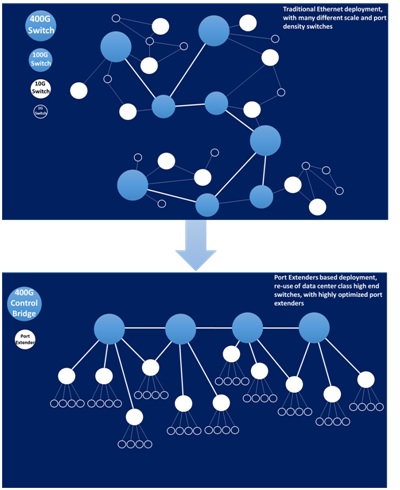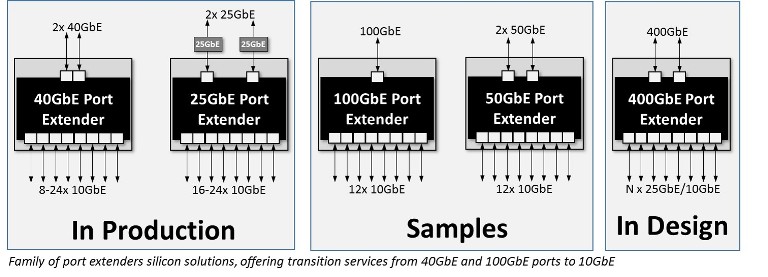- PRODUCTS
- COMPANY
- SUPPORT
- PRODUCTS
- BY TYPE
- BY MARKET
- COMPANY
Our Company
Media
Contact
- SUPPORT
The New Scaling Paradigm: Ethernet Port Extenders
Over the last three decades, Ethernet has grown to be the unifying communications infrastructure across all industries. More than 3M Ethernet ports are deployed daily across all speeds, from FE to 100GbE. In enterprise and carrier deployments, a combination of pizza boxes — utilizing stackable and high-density chassis-based switches — are used to address the growth in Ethernet. However, over the past several years, the Ethernet landscape has continued to change. With Ethernet deployment and innovation happening fastest in the data center, Ethernet switch architecture built for the data center dominates and forces adoption by the enterprise and carrier markets. This new paradigm shift has made architecture decisions in the data center critical and influential across all Ethernet markets. However, the data center deployment model is different.
How Data Centers are Different
 Ethernet port deployment in data centers tends to be uniform, the same Ethernet port speed whether 10GbE, 25GbE or 50GbE is deployed to every server through a top of rack (ToR) switch, and then aggregated in multiple CLOS layers. The ultimate goal is to pack as many Ethernet ports at the highest commercially available speed onto the Ethernet switch, and make it the most economical and power efficient. The end point connected to the ToR switch is the server NIC which is typically the highest available speed in the market (currently 10/25GbE moving to 25/50GbE). Today, 128 ports of 25GbE switches are in deployment, going to 64x 100GbE and beyond in the next few years. But while data centers are moving to higher port density and higher port speeds, and homogenous deployment, there is still a substantial market for lower speeds such as 10GbE that continues to be deployed and must be served economically. The innovation in data centers drives higher density and higher port speeds but many segments of the market still need a solution with lower port speeds with different densities. How can this problem be solved?
Ethernet port deployment in data centers tends to be uniform, the same Ethernet port speed whether 10GbE, 25GbE or 50GbE is deployed to every server through a top of rack (ToR) switch, and then aggregated in multiple CLOS layers. The ultimate goal is to pack as many Ethernet ports at the highest commercially available speed onto the Ethernet switch, and make it the most economical and power efficient. The end point connected to the ToR switch is the server NIC which is typically the highest available speed in the market (currently 10/25GbE moving to 25/50GbE). Today, 128 ports of 25GbE switches are in deployment, going to 64x 100GbE and beyond in the next few years. But while data centers are moving to higher port density and higher port speeds, and homogenous deployment, there is still a substantial market for lower speeds such as 10GbE that continues to be deployed and must be served economically. The innovation in data centers drives higher density and higher port speeds but many segments of the market still need a solution with lower port speeds with different densities. How can this problem be solved?
Bridging the Gap
Fortunately, the technology to bridge lower speed ports to higher density switches has existed for several years. The IEEE standards codified the 802.1br port extender standard as the protocol needed to allow a fan-out of ports from an originating higher speed port. In essence, one high end, high port density switch can fan out hundreds or even thousands of lower speed ports. The high density switch is the control bridge, while the devices which fan out the lower speed ports are the port extenders.
Why Use Port Extenders
In addition to re-packaging the data center switch as a control bridge, there are several unique advantages for using port extenders:
Port extenders are only a fraction of the cost, power and board space of any other solution aimed for serving Ethernet ports.
Port extenders have very little or no software. This simplified operational deployment results in the number of managed entities limited to only the high end control bridges.
Port extenders communicate with any high-end switch, via standard protocol 802.1br. Additional options such as Marvell DSA, or programmable headers are possible.)
Port extenders work well with any transition service: 100GbE to 10GbE ports, 400GbE to 25GbE ports, etc.
Port extenders can operate in any downstream speed: 1GbE, 2.5GbE, 10GbE, 25GbE, etc.
Port extenders can be oversubscribed or non-oversubscribed, which means the ratio of upstream bandwidth to downstream bandwidth can be programmable from 1:1 to 1:4 (depending on the application). This by itself can lower cost and power by a factor of 4x.
Marvell Port Extenders
Marvell has launched multiple purpose-built port extender products, which allow fan-out of 1GbE and 10GbE ports of 40GbE and 100GbE higher speed ports. Along with the silicon solution, software reference code is available and can be easily integrated to a control bridge. Marvell conducted interoperability tests with a variety of control bridge switches, including the leading switches in the market. The benchmarked design offers 2x cost reduction and 2x power savings. SDK, data sheet and design package are available. Marvell IEEE802.1br port extenders are shipping to the market now. Contact your sales representatives for more information.
Recent Posts
Archives
Categories
- 5G (12)
- AI (30)
- Automotive (26)
- Cloud (16)
- Coherent DSP (10)
- Company News (103)
- Custom Silicon Solutions (7)
- Data Center (55)
- Data Processing Units (22)
- Enterprise (25)
- ESG (6)
- Ethernet Adapters and Controllers (12)
- Ethernet PHYs (4)
- Ethernet Switching (41)
- Fibre Channel (10)
- Marvell Government Solutions (2)
- Networking (36)
- Optical Modules (15)
- Security (6)
- Server Connectivity (26)
- SSD Controllers (6)
- Storage (22)
- Storage Accelerators (2)
- What Makes Marvell (40)
Copyright © 2025 Marvell, All rights reserved.
- Terms of Use
- Privacy Policy
- Contact


